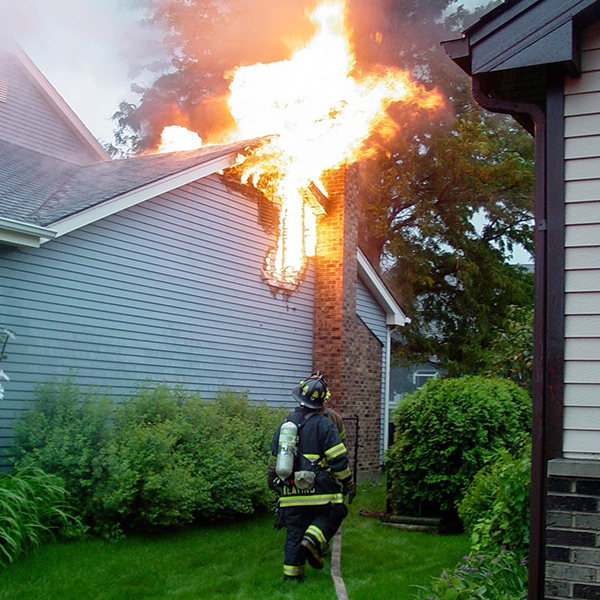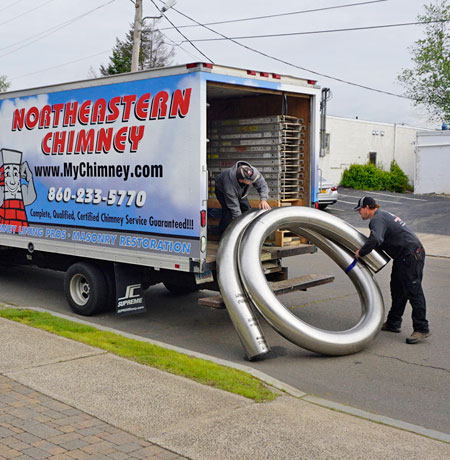How To Prevent A Chimney Fire This Winter
Winter is here. People with fireplaces are looking forward to cozy nights by the fire. While fireplaces give warmth and an ambiance you can’t get with other heating systems, they can be dangerous. Statistics suggest there are over 25,000 chimney fires annually, many of them going undetected. However, with proper maintenance and precautions, you can prevent a disaster. Here’s how to protect your home and family against chimney fires.
 What Causes Chimney Fires?
What Causes Chimney Fires?
Most chimney fires happen because of creosote buildup. Creosote is a byproduct of burning wood. It starts as a powder and builds to a thick, sticky coating that’s extremely flammable. Creosote builds up in the flue over time, especially if you burn the wrong wood. Chimney fires range from a slow smoldering burn to an explosive blaze that could spread to the entire house.
Tips for Preventing Chimney Fires
Schedule a Professional Inspection and Cleaning
The most important thing you can do to keep your home and family safe is to hire a professional chimney sweep to clean and inspect your chimney. Pros can identify potential problems, such as creosote buildup and structural damage, that could put you at risk of a fire.
Pros have the proper tools to clean the flue of creosote and obstructions that can lead to a disaster.
Burn the Right Kind of Wood
Seasoned firewood is the best to burn in your fireplace. Oak, hickory, or maple, for example, are dense and, when properly dried, provide long-lasting heat. Softwoods like pine can be good for kindling but are less efficient for heating.
Green or unseasoned firewood contains too much moisture, creating more smoke and faster creosote buildup. As mentioned, creosote is dangerous and a major cause of chimney fires. Always burn wood that’s been seasoned for at least six months to ensure high heat output and less smoke.
Also, don’t burn trash in the fireplace. Trash, painted, or stained wood can release toxins and leave a residue in the flue.
Install a Chimney Cap
Chimney caps are inexpensive but vital components. They prevent leaves, debris, and animals from getting in and causing blockages. During a professional inspection, ask the chimney technician to check the cap for damage and fit.
Use the Fireplace Correctly
Using the fireplace correctly can significantly reduce the chance of a fire.
Build small fires. Overloading a fireplace with too much wood creates a dramatic fire but produces more smoke and creosote. Always ensure the damper is open before lighting a fire to create a good draft and prevent smoke from flowing back into the room. Lastly, consider using a fireplace screen to prevent sparks and embers from flickering into the room and causing a fire.
Clear the Fireplace and Chimney Area
Keep a “safe zone” around the fireplace by keeping flammable materials, like furniture, rugs, toys, and curtains, at least three feet away. Also, never leave the fire unattended. An errant spark can become a disaster in a few minutes.
Watch for Warning Signs
These warning signs indicate a potential problem with the chimney:
- If your fireplace produces excessive smoke, it could be due to a blockage or insufficient airflow.
- A roaring or rumbling noise from the chimney could indicate a fire.
- A strong, ashy odor could mean you have a dangerous creosote buildup.
Install Smoke Detectors
The National Fire Protection Association released a study showing that “nearly three out of five home fire deaths were caused by fires in properties with no smoke alarms or with smoke alarms that failed to operate.”
Like a chimney cap, smoke detectors are inexpensive but essential for people who use a fireplace.
 Upgrade the Chimney Liner
Upgrade the Chimney Liner
Chimney liners are protective barriers between the house and the chimney’s hot gases. If the liner is old, cracked, or damaged, it could put your home at risk. Modern stainless steel or clay liners are more efficient and may be required by your local building codes.
Preventing chimney fires is easy and inexpensive. A well-cleaned and maintained chimney is a safe chimney.
Call Northeastern Chimney Inc
to get your chimney winter-ready. We’re members of the National Chimney Sweep Guild and the Chimney Safety Institute of America. We proudly serve residents throughout Hartford, Tolland, and Litchfield County.
The post How To Prevent A Chimney Fire This Winter appeared first on .
This post first appeared on https://www.mychimney.com
 As you check all your lists, don’t forget the essential maintenance checklist before the colder weather sets in. Now is the time to prepare to get your fireplace and chimney ready for the burning season.
As you check all your lists, don’t forget the essential maintenance checklist before the colder weather sets in. Now is the time to prepare to get your fireplace and chimney ready for the burning season. 



